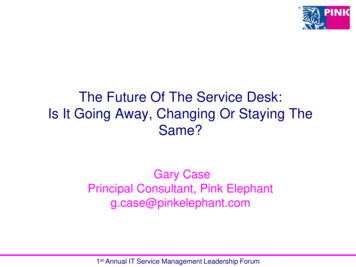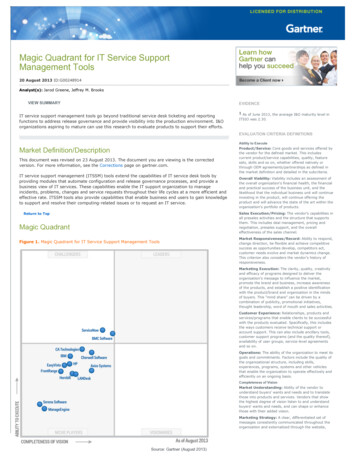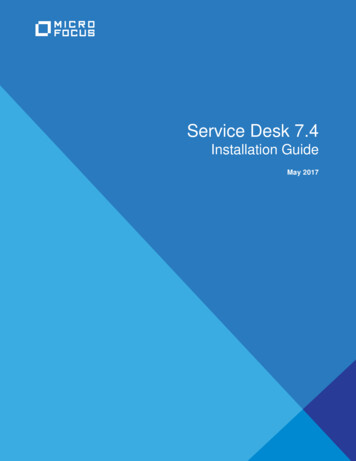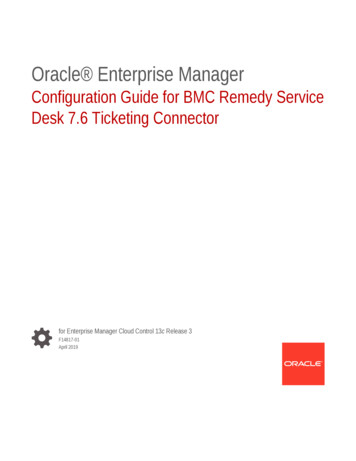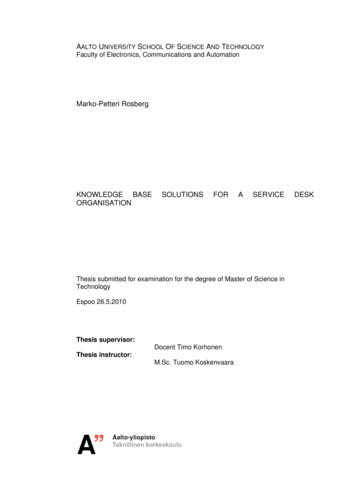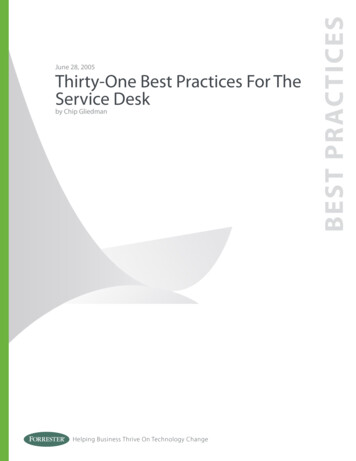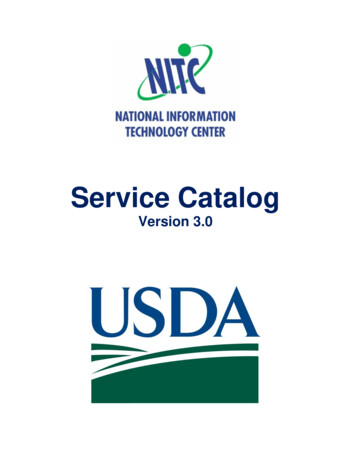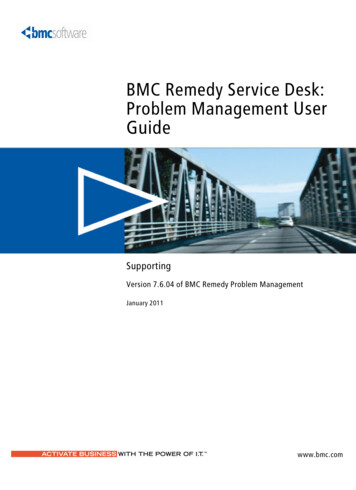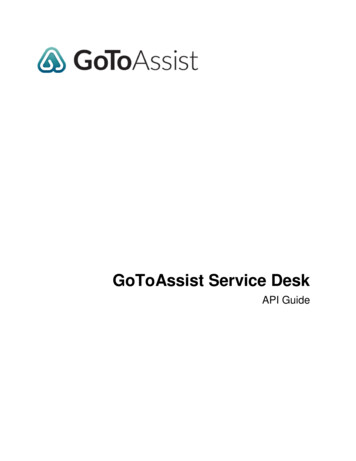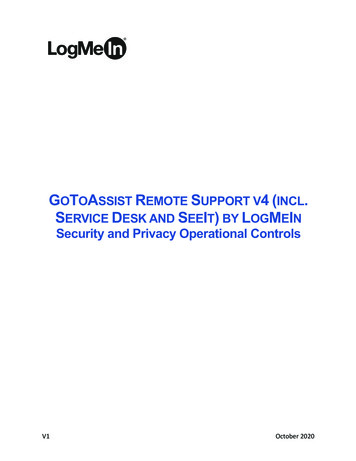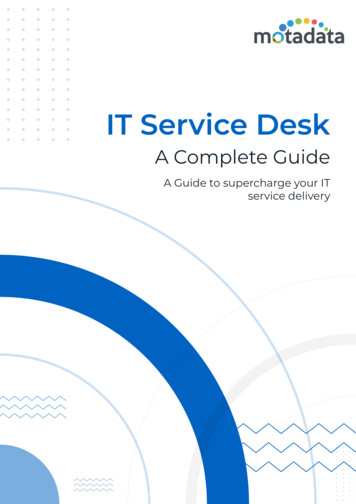
Transcription
IT Service DeskA Complete GuideA Guide to supercharge your ITservice deliveryEbook - IT Service Desk - A Complete Guide
Table of Contents1) Introduction . . . . . . . . . . . . . . . . . . . . . . . . . . . . . . . . . . . . . . . . . . . . . . . . . . . . . . . . . . . . . . . . . . . . . . . . . . . . . . . . . . . . . . . . . . . . . . . . . .32) What is an IT Service Desk? . . . . . . . . . . . . . . . . . . . . . . . . . . . . . . . . . . . . . . . . . . . . . . . . . . . . . . . . . . . . . . . . . . . . . . . . . . . . . . . . . .33) Functions of a Service Desk? . . . . . . . . . . . . . . . . . . . . . . . . . . . . . . . . . . . . . . . . . . . . . . . . . . . . . . . . . . . . . . . . . . . . . . . . . . . . . . . . .34) What are the common types of Services Desk? . . . . . . . . . . . . . . . . . . . . . . . . . . . . . . . . . . . . . . . . . . . . . . . . . . . . . . . . . . . . . .45) What are the benefits of having an IT service desk? . . . . . . . . . . . . . . . . . . . . . . . . . . . . . . . . . . . . . . . . . . . . . . . . . . . . . . . . . .46) How service desk is different from helpdesk? . . . . . . . . . . . . . . . . . . . . . . . . . . . . . . . . . . . . . . . . . . . . . . . . . . . . . . . . . . . . . . . .47) How a service desk fits into IT service management? . . . . . . . . . . . . . . . . . . . . . . . . . . . . . . . . . . . . . . . . . . . . . . . . . . . . . . . .58) 4 Ways to align your Service Desk to business operations . . . . . . . . . . . . . . . . . . . . . . . . . . . . . . . . . . . . . . . . . . . . . . . . . . . .58.1) Automation . . . . . . . . . . . . . . . . . . . . . . . . . . . . . . . . . . . . . . . . . . . . . . . . . . . . . . . . . . . . . . . . . . . . . . . . . . . . . . . . . . . . . . . . . . . . . . . .68.2) Shift Left . . . . . . . . . . . . . . . . . . . . . . . . . . . . . . . . . . . . . . . . . . . . . . . . . . . . . . . . . . . . . . . . . . . . . . . . . . . . . . . . . . . . . . . . . . . . . . . . . .68.3) Focus on Old Tickets . . . . . . . . . . . . . . . . . . . . . . . . . . . . . . . . . . . . . . . . . . . . . . . . . . . . . . . . . . . . . . . . . . . . . . . . . . . . . . . . . . . . . .78.4) Provide Consistent User Experience . . . . . . . . . . . . . . . . . . . . . . . . . . . . . . . . . . . . . . . . . . . . . . . . . . . . . . . . . . . . . . . . . . . . . . .79) IT Service Management Trends to Watch Out . . . . . . . . . . . . . . . . . . . . . . . . . . . . . . . . . . . . . . . . . . . . . . . . . . . . . . . . . . . . . . . .89.1) Increase focus on customer experience . . . . . . . . . . . . . . . . . . . . . . . . . . . . . . . . . . . . . . . . . . . . . . . . . . . . . . . . . . . . . . . . . . .89.2) The craze for AI will normalize . . . . . . . . . . . . . . . . . . . . . . . . . . . . . . . . . . . . . . . . . . . . . . . . . . . . . . . . . . . . . . . . . . . . . . . . . . . .89.3) Adoption of agile methods . . . . . . . . . . . . . . . . . . . . . . . . . . . . . . . . . . . . . . . . . . . . . . . . . . . . . . . . . . . . . . . . . . . . . . . . . . . . . . .89.4) Self-service will play a prominent role . . . . . . . . . . . . . . . . . . . . . . . . . . . . . . . . . . . . . . . . . . . . . . . . . . . . . . . . . . . . . . . . . . . .99.5) ITIL 4 will have a prominent impact . . . . . . . . . . . . . . . . . . . . . . . . . . . . . . . . . . . . . . . . . . . . . . . . . . . . . . . . . . . . . . . . . . . . . .99.6) Focus on people . . . . . . . . . . . . . . . . . . . . . . . . . . . . . . . . . . . . . . . . . . . . . . . . . . . . . . . . . . . . . . . . . . . . . . . . . . . . . . . . . . . . . . . . . .910) 11 Service Desk Best Practices to Supercharge your Service Delivery . . . . . . . . . . . . . . . . . . . . . . . . . . . . . . . . . . . . . . . .1010.1) Practices to Better Productivity . . . . . . . . . . . . . . . . . . . . . . . . . . . . . . . . . . . . . . . . . . . . . . . . . . . . . . . . . . . . . . . . . . . . . . . . . . .1110.2) Practices to Better Manage Metrics . . . . . . . . . . . . . . . . . . . . . . . . . . . . . . . . . . . . . . . . . . . . . . . . . . . . . . . . . . . . . . . . . . . . . .1210.3) Practices for Optimization . . . . . . . . . . . . . . . . . . . . . . . . . . . . . . . . . . . . . . . . . . . . . . . . . . . . . . . . . . . . . . . . . . . . . . . . . . . . . . . . 1210.4) Practices to manage Knowledge . . . . . . . . . . . . . . . . . . . . . . . . . . . . . . . . . . . . . . . . . . . . . . . . . . . . . . . . . . . . . . . . . . . . . . . . . 1211) Important Service Desk Metrics to Measure. . . . . . . . . . . . . . . . . . . . . . . . . . . . . . . . . . . . . . . . . . . . . . . . . . . . . . . . . . . . . . . . . .1211.1) 7 Service Desk Metrics. . . . . . . . . . . . . . . . . . . . . . . . . . . . . . . . . . . . . . . . . . . . . . . . . . . . . . . . . . . . . . . . . . . . . . . . . . . . . . . . . . . .1211.2) Common Mistakes while Setting Service Desk Metrics . . . . . . . . . . . . . . . . . . . . . . . . . . . . . . . . . . . . . . . . . . . . . . . . . . . . 1512) Conclusion . . . . . . . . . . . . . . . . . . . . . . . . . . . . . . . . . . . . . . . . . . . . . . . . . . . . . . . . . . . . . . . . . . . . . . . . . . . . . . . . . . . . . . . . . . . . . . . . . .Ebook - IT Service Desk - A Complete Guide152
1) IntroductionAn IT service desk is an integral part of an organization’s IT operations. It’s relevant for entities of all sizes, and plays akey role in making sure that IT services meet key business objectives.In an organization, a service desk acts as a catalyst for digital transformation, which is a major trend affecting almostevery industry.In a report from Forturum, 41.4% of their respondents (companies) had a dedicated digital transformation team.In a nutshell, a service desk plays an important role in enhancing service delivery and user experience, and it willcontinue to do so in the coming years.According to Service Desk Benchmark Report V.9: 44% of their respondents have said that they expect anincrease in the staff managing their service desk.In this guide we will break down the concept of service desk in to what, why and how.2) What is an IT Service Desk?An IT service desk is a single point of contact for internalcustomers (employees) to get services from their ITdepartment.In a service desk, requests are registered as tickets, which iswhy it’s also called a ticket management system.ITIL, a standard framework for implementing a servicedesk, has identified 26 processes and 4 functions that canbe mapped on to service lifecycle stages.3) Functions of a Service Desk?The primary role of a service desk is to deliver services. Apart from that, it captures major incidents in an organization.In most organizations, the service desk is not just limited to IT. It is integrated into other business processes like: Travel booking. Onboarding of new employees. Infrastructure management. Onboarding of new vendors and their management. Data and reporting. Documentation Management.In our ITSM solution, Motadata ServiceOps, we provide predefined templates to take care of common use cases likeNew Employee On-boarding.Ebook - IT Service Desk - A Complete Guide3
4) What are the common types of Services Desk?ITIL has clearly stated that there are four types of service desk. They are as follows: Local Service Desk: Such a service desk is generally situated inside the premise of an organization and caters to thedemands of users in close proximity. The capacity of such a service desk is limited and suitable for small andmedium-size enterprises. Centralize Service Desk: A central service desk eliminates the requirement of maintaining multiple service desksacross several locations. It allows greater efficiency and results in significant cost reduction. Virtual Service Desk: When a service desk delivers services through online, and gives the sense of a central servicedesk even though it might be distributed across multiple locations, then it is a virtual service desk. Most modernservice desks are virtual service desk. Follow the Sun: This kind of service desk runs 24 hours. This is achieved by combining two or more service deskssituated across multiple geographical locations.5) What are the benefits of having an IT service desk?The primary role of a service desk is to deliver services. Apart from that, it captures major incidents in an organization.In most organizations, the service desk is not just limited to IT. It is integrated into other business processes like: Most modern service desks leverage a cloudarchitecture to give services anytime anywhere. Withservice desk, people can report their issues/service froma portal, via email or a mobile app anytime. A service desk ensures, services are delivered in astandardized way and that there are no gaps in theexpectations of the end-users. A service desk brings in the power of workflowautomation that automates repetitive processes andservice level agreements so services are delivered ontime. A service desk generates a lot of data and makesreporting a lot easier. Apart from that, it also gauges thesentiment of the end-users.According to a report from SDI, 41% of their IT respondents have said that they see customer satisfaction as theirmain indicator of success.6) How service desk is different from helpdesk?People tend to confuse between a service desk and a helpdesk, but they are different.A helpdesk is a limited version of a service desk. It was designed to fix IT issues for IT teams. The traditional helpdeskEbook - IT Service Desk - A Complete Guide4
ignores the end-user experience.A service desk is everything a helpdesk is and more. It takes into consideration what is called a service lifecycle thatincludes handling incidents and service requests. Click Here to Read more about the difference.V/SHelpdeskService Desk7) How a service desk fits into IT service management?IT service management deals with service planning, designing, delivering, supporting and managing.A service desk is a subset of ITSM that includes: Incident management Problem Management Change Management Knowledge Management Self-service Service Requests Integration with a CMDB8) 4 Ways to align your Service Desk to business operationsAs an IT leader, it’s important to step back, sometimes, andview what you can do better with your service desk.Because small issues and inefficiencies can easily add upto day-to-day chaos.In organizations where IT services are aligned withbusiness objectives, they are more likely to makeinvestments in new technologies like AI & ML. Periodicreviews will make sure that the alignment stays.Now we are going to look at few areas where puttingefforts can yield significant result.Ebook - IT Service Desk - A Complete Guide5
8.1) AutomationAutomation is one of the “WOW” words of this era. A quick Google trend analysis of the keyword IT Automation showsa steady increase in people’s interest since 2004.100755025Jan 1, 2004Oct 1, 2008Jul 1, 2013Apr 1, 2018The main reason for this uptick is that people want to do more with less in the face of ever-increasing need.Automation generally comes as a part and parcel of an ITSM solution. Automation can be a quick win if you haven’texplored it earlier. If you are considering it then these are the five areas where automation can yield significant results. Ticket categorization (Workflow to automatically categorize tickets based on certain parameters). Assignment of a ticket to a technician (Auto assignment of tickets based on smart algorithm). Approval for a ticket (Create sequential workflows to automatically handle approvals). Notification to the requester (Automatically send emails when certain conditions are fulfilled). Closing of a ticket (Workflow to automatically close a ticket that has the status resolved).Success with automation is not only about saving time and money; it’s also about customer experience and makingsure ITSM processes are followed.8.2) Shift LeftIt is an ITSM concept that aims to make the requesters self-reliant.The idea is to move most of the provisions to resolve an issue closer to a requester. This means tasks that techniciansare doing, at various levels, to resolve issues will ultimately be done by the requesters.Why shift?This idea has a significant cost advantage; think about it, the problem solving that your technicians are doing if doneby the requesters can save a ton of money.How it is done?Most modern service desks come equipped with a self-service portal; couple that with a robust knowledge base,requesters can figure out the solution to common problems by themselves.When you achieve a successful shift, you empower your requesters and the workforce at large, because everyone isdoing the work they are meant to do.Ebook - IT Service Desk - A Complete Guide6
8.3) Focus on Old TicketsThese are tickets that remain unresolved and mess up SLAs. In most cases, such tickets are forgotten until it is foundby a technician drowning in backlogs. This is why you need a plan to resolve such old tickets.Eventually, your service desk will get tickets that are hard to resolve, but if your technicians are focused and continuethe communication with requesters, letting them know the reason for the delay, then such tickets can be resolvedwithout the pile-up. Here time-based email notifications can be useful that can keep the requesters aware of anyproblem if the ticket is not resolved within the stipulated time.If you are someone who collects monthly performance stats of your service desk then make sure to add the volume ofaged tickets. This will help you to keep a tap on them.Motadata ServiceOps ITSM solution allows for easy creation of reports showing tickets still pending grouped bytechnicians.8.4) Provide Consistent User ExperienceThe main purpose of a service desk is to provide consistent user experience to requesters. This is achieved becausemost modern ITSM solutions come equipped with a framework for service design.In general, services are organized in a catalog and made visible on a self-service portal.Each service on the portal is created from a template. In Motadata ServiceOps, a template supports the following: Custom form Dedicated automation (workflow, SLA, Scenario, and Approval) TasksServices offered in a designed way offer more control (by IT admins) and ensure consistent experience to requester.Ebook - IT Service Desk - A Complete Guide7
9) IT Service Management Trends to Watch OutITSM is a hot topic for people managing IT infrastructurebecause there’s always something new every few months.Last month we saw the release of ITIL V4, which was amajor step towards the future. Read more about ITIL V4.AI was a big topic in 2019, and expect similaradvancements in this year as well.Let’s dive into some major trends of 2020 that might affectyou this year.201920209.1) Increase focus on customer experienceWith the release of ITIL V4, there’s no doubt customer experience is at the focal point.According to Service Desk Benchmarking Report V.9, 79% of their respondents use the customer feedback data toimprove their IT services.Even ITSM experts are echoing the same thing. The trend will continue to persist in 2020 even though it started in 2019.The expectations of employees of what IT can do for them have changed; they have realized that for their productivityIT is a big enabler. The increased interaction between the employees and IT is one of the reasons why ITSMprofessionals are focusing on user experience.9.2) The craze for AI will normalizeThere’s no doubt that AI is transforming the ITSM landscape. But the excitement will normalize as people will realizemore concrete use cases of AI, which will gradually reduce the uncertainties around it.The benefits of an AI-powered ITSM tool has become more meaningful. For example: Chatbots are reducing the workload of IT technicians by handling requesters with known issues. AI-powered smart suggestions allow requesters to discover solutions from the knowledgebase before filling a ticket. AI is optimizing the way tickets are assigned to technicians.According to a survey by Axelos, 77% of their respondents have said that AI and Machine Learning would free upITSM professionals from routine tasks thus helping them to focus on pressing issues.9.3) Adoption of agile methodsOrganizations are adopting methods like agile and scrum in ITSM processes. The reason being to design services theyield maximum customer satisfaction while keeping the organization goals in mind.According to ITSM Academy, Companies are adopting agile service management which is a hybrid between agilemethods and ITSM practices.Ebook - IT Service Desk - A Complete Guide8
9.4) Self-service will play a prominent roleSelf-service has become a cornerstone topic for many ITSM practitioners because it helps in managing costs andmaking IT technicians more productive.With self-service, requesters are less dependent on technicians for common, known issues thus reducing theirworkload.According to a survey by Service Desk Institute, 69% oftheir respondents have reported that they use somekind of self-service or similar automation.Automation is an important component of self-service;keeping that in mind, Motadata ServiceOps has created aself-service portal that has a robust service catalogpowered by automation and knowledgebase that focuseson easy searchability and accessibility.9.5) ITIL 4 will have a prominent impactITIL 4 aims to answer the question, how to combine the best practices of ITIL with the methodologies of agile.With ITIL 4, organizations are redesigning their ITSM processes with the aim of not creating unnecessary rigidity.The important impact of ITIL 4 will be that companies adopting the new version can decide on ITIL processes suitablefor their business.9.6) Focus on peopleAn organization is made up of people, and to manage them processes exist. So people are important not just forprocess sake but to maintain the overall culture of the organization.ITSM creates an intersection between people and processes. So far, the user side was receiving all the attention; noworganizations are realizing that the technician side is as important as the user. That is why companies are pushing for ateam-centric culture in their service desk.Ebook - IT Service Desk - A Complete Guide9
10) 11 Service Desk Best Practices to Supercharge your Service DeliveryA service desk is the nerve center for all activities related to IT service delivery. It’s at the forefront of all interactions anorganization has with its requesters.Implementing a service desk involves processes, workflows, and domain knowledge. That’s why most people stick to aframework when setting up a service desk. Learn more about the most popular ITSM framework.A service desk comes with numerous challenges that canbe overcome if you are aware of the best practices.We will discuss the best practices grouped by the following: Practices to better productivity. Practices to better manage metrics. Practices for optimization Practices to manage knowledge.10.1) Practices to Better ProductivityThe primary reason for having a service desk is to drive positive business outcomes. A healthy service desk promotesbehaviors and activities that are geared toward achieving business objectives. Some of the best practices to maximizeproductivity are: Customize your tool according to your business: A service desk is one of the many aspects of an ITSM tool. Mostmodern ITSM tools are customizable which means you can do the following: create custom forms, create workflowsthat align with your existing business processes, create the perfect service catalog, etc. All these customizations willgive you a productive service desk. Allocate tickets and tasks dynamically: Make sure technicians are assigned tickets and tasks after taking intoconsideration their workload so they can maintain their optimum efficiency. Motadata ServiceOps has the feature toshow the workload of every technician. Adopt everyone-is-a-technician mindset: The department that is handling the service desk; everyone in that is atechnician including the managers; everyone should get adequate training to handle customer queries. In theunlikely event of a ticket flood, an extra pair of hands is always appreciated.10.2) Practices to Better Manage MetricsMetrics help you to quantify the outcomes of your efforts. Having the right metrics steer you towards a better servicedesk, and the wrong ones give the impression that things are ok even though they are not. Here are the best practiceswith regards to metrics: You don’t need to report everything that you can measure: An ITSM solution is a complex software that works inmysterious ways behind the scenes for an average user. That is why it is important to start with a question beforemoving on to a metric. For example, if you are thinking that technicians are taking more time in resolving issues,then it makes sense to track something like the average resolution time of all technicians. Use both subjective and object measures: In case you have a doubt that the efficiency of the service desk is goingEbook - IT Service Desk - A Complete Guide10
down then you can use something like average resolution time to substantiate. But it won’t tell the reason behind thedecrease; for that, you might require something like sentiment analysis. Here both subject and object measures playan important role. Be consistent with your measures: Consistent measures help you in building trends, which help to identifyproblems that might crop up in the future. For example, a trend line of tickets by category might give you thecategories that require special attention.10.3) Practices for OptimizationAn ITSM tool, like Motadata ServiceOps, can streamline your service delivery processes so end users can get a betterexperience. Streamlining is done so you can deliver services faster. Here are some best practices that you shouldconsider while streamlining. Leverage workflows to avoid queuing: A queue of tickets is something you should avoid because it hampers youraverage resolution time metric. Leverage the automation features of your ITSM tool handle recurring tickets sotechnicians can work on tickets that require actual attention. For example, ServiceOps allows for workflows that cansend a predefined solution to common issues and even close them if required. Every ticket should have an owner: Accountability is important if you want tickets to be resolved on time. When aticket is assigned the technician tries to resolve it within the time limit so he can maintain his average time. Theauto-assignment is an inbuilt feature of ServiceOps which uses a proprietary algorithm to perform the assignments. Create SLA and escalation: An SLA is an agreement between you and your end-users that dictates the quality andavailability of a service. An SLA also has escalation clauses that dictate what will happen when the SLA is violated.SLAs are important to keep your services on-time; Motadata ServiceOps has built-in SLAs to cover common usecases.10.4) Practices to manage KnowledgeEffective knowledge management is the difference between self-service and long ticket queues. It gives you arepository of best practices and solutions that both technicians and requesters can use to solve their problems. Hereare some best practices with regards to knowledge management: Technicians should participate in knowledge creation:Technicians should actively participate in creatingknowledge articles in order to capture solutions tocommon problems. This will eventually instill a mind-setamong technicians to treat the knowledge base as thego-to place to find solutions. Make Knowledgebase accessible to the requesters:Knowledge should be accessible to the requesters sothey can search for a solution to their problems.Motadata ServiceOps offers an advanced search bar onthe service portal so requesters can perform self-service.Learn about the steps that you can take to build an awesome knowledge base.Ebook - IT Service Desk - A Complete Guide11
11) Important Service Desk Metrics to MeasureService desk or IT teams are critical to organisations forensuring business continuity and service delivery. Hence, itbecomes important for IT organizations to use a slew ofmetrics to measure how efficient their service desk is.With the recent advancement in IT Service Management(ITSM), the reporting capabilities offer multiple KPI metricsthat can be measured and monitored. So, with theincrease in service desk metrics, it becomes even moredifficult to zero down on which metrics to measure.We will now discuss 7 KPIs that are aimed at achievingTicket VolumeTrendsSLAComplianceAvg. TicketResolution TimeCost of EachTicketTickets Resolvedon 1st CallTotalDowntimeSoftware License UtilizationProductivity, Business Continuity, Timely service deliveryand Control Cost.11.1) 7 Service Desk Metrics11.1.1) Ticket Volume TrendIt is the total number of tickets that have come to service desk in a particular time frame.Motadata ITSM dashboard allows for easy creation of line graphs to highlight ticket volume over a specific time ulAugSepOctNovDecObjective to measure the metricsAnalysis of monthly ticket volume would allow IT managers to optimize incidents and service request that helps inhandling the ticket load effectively.Actionable for Service Desk Manager Identify peak loads to optimize resource management Create talent pool / increase bench strength Identify training needsEbook - IT Service Desk - A Complete Guide12
11.1.2) The average time it takes to resolve a ticketThis is one of the important metrics related to incident / ticket management, which summarizes the time taken toresolve all tickets divided by the no. of tickets.In Motadata ITSM, service desk manager can create similar reports for individual technicians grouped by days, weeksor months.Objective to measure the metricsThe report helps organization in planning and designing OLAs (Operational Level Agreement) and SLAs (Service LevelAgreement). It also helps in measuring individual / team productivity.Actionable for Service Desk Manager Analyze service request patterns to build a robustknowledge base to resolve common issues i.e. passwordreset Automate manual activities with workflow automation,so as to reduce the time required in assigning ticketmanually Properly prioritize and categorize tickets to reduceincorrect ticket assignments Categorise and tag similar tickets so as to reduce thetime wasted by multiple agents in resolving the sameset of issues individually11.1.3) Number of tickets resolved on first callA ticket is considered as resolved on the first call when it’s resolved at a tier 1 level and doesn’t have a comment threadwith more than 2 comments.In Motadata, the report can be grouped by technicians and can be generated for a specific time period.Objective to measure the metricsIt helps IT managers to measure the service desk efficiency and allocate technicians across different levels of supportbased on their expertise.Actionable for Service Desk Manager Analyze service request patterns to build a robust knowledge base to resolve common issues i.e. password reset If the calls are not resolved on first call, training needs could be identified so as to upgrade technician’s skill. Create detailed form so as to collect and capture all the relevant information that would be required in order toresolve user tickets. With workflow automation, automatically route tickets to the right technician or group.11.1.4) Total DowntimeDowntime refers to the duration during which critical services of IT were not available. IT managers can sum-up theresolution time of such tickets (Created by the NMS tool) to ascertain the total downtime.Ebook - IT Service Desk - A Complete Guide13
Motadata ITSM can be integrated with any NMS tool that allows automatic creation of tickets in the event of systemfailure.Objective to measure the metricsKeep lost business hours to the bare minimum due to unavailability of IT Services. It also helps IT managers to figureout whether their IT is delivering the promised level of services as defined in Service Level Agreement (SLAs).Actionable for Service Desk Manager Properly plan application upgrades, server migration, and other IT change related processes. Sensitize IT teams on the indirect cost incurred by businesses in case of IT Failure Prepare IT teams to analyse the past and anticipate future outages for effectively handling service desk11.1.5) SLA ComplianceA ticket incident/request is considered violated, when it’s not resolved within the time stipulated in the associated SLA.The compliance report in Motadata ITSM, gives the total count of SLA violations for a particular period. i.e. % of ticketsresolved within the agreed SLA.Objective to measure the metricsIt helps in measuring the number of times SLA has been violated.Actionable for Service Desk Manager Match business expectation with IT Capabilities to setachievable SLAs Sensitize IT teams on business impact due to SLAviolations Set escalation matrix, in case SLA’s are violated11.1.6) Cost per ticketIt is the operating cost of running IT support divided by the total number of tickets during a particular period.Objective to measure the metricsKeep in-check the cost incurred per ticket, which is crucial for budgeting.Actionable for Service Desk Manager Identify technician training needs, to keep the cost in control Logical workflow automation to assign tickets to right technician Create a robust knowledge base11.1.7) Software license utilization reportThe report tells how many licensed software’s are installed across the organization against what was procured. It has adirect bearing on the decision of how many licenses to be purchased for a particular software.Objective to measu
entralize Service Desk:C A central service desk eliminates the requirement of maintaining multiple service desks across several locations. It allows greater efficiency and results in significant cost reduction. irtual Service Desk:V When a service desk delivers services through online, and gives the sense of a central service

